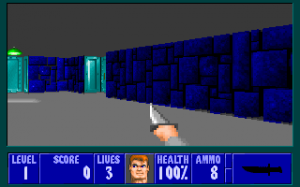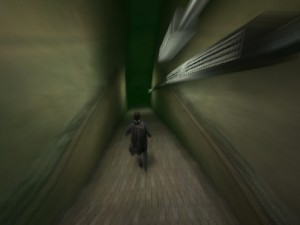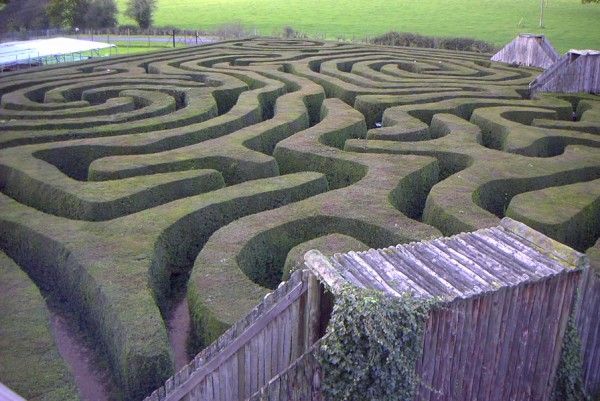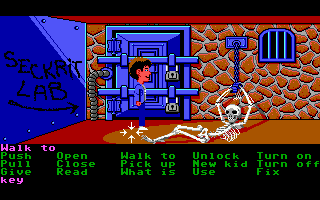So much for writing these articles in a bi-weekly rhythm. Sorry about that. Regardless, here’s the third installment.
Aliases: The Labyrinth*, the Puzzle, the Dungeon, the Cave, the Caverns
Sidenote: A labyrinth has only one convoluted path and no crossroads. A maze has dead endss and at least one correct path. Thus a maze is not a labyrinth but people often confuse the terms, which is why the term is listed above.
The Maze, like the Wilderness, is a common space. My theory for this lies in the fact that many video games focus very much on challenges, and these two space archetypes have very strong obstacle components. You’ll see what I mean by that during this article.
Core Theme
The Maze is at it’s heart a spatially complex place. Finding one’s way around a Maze is not easy to do because the space is deliberately made hard to read and understand. Either through visual similarities, structural complexities, shifting tectonics, impossible connections and other things. This makes it very difficult for the visitor to create cognitive maps of the region.
So here the key challenge is to get from point A to point B through the seemingly interchangeable corridors and rooms. The goal is to reach the Mazes exit (or a special place within) to progress. And to do so one has to successfully navigate the complex layout.
As with the Wilderness, the Maze is not a place of habitation for the visitor. He is a stranger and clearly not at home here. However there’s less of an urgent threat, so the visitor may linger and ponder his choices before pressing on.
Diegetic Layer
In the storyworld the Maze is a place that people stay away from. It is less an actively hostile place like the Wilderness but its danger stems from it’s treacherous structure. Where the Wilderness has a danger that radiates outward, the Maze draws it, it swallows people: Many an adventurer or curious youth ventured forth into the Maze only to get lost forever.
So whether the Maze is of natural or man-made origin, it is not a place to live in. Instead it is feared and guarded or locked as to prevent other unfortunate souls from vanishing within it’s cavernous depths. And there are certainly many myths and stories surrounding the origin and/or purpose of a place so strange. All of them built on half-truths since there’s nobody who can bring forth actual first hand knowledge from within. It’s a sort of perceptual void.
Spatio-visual Layer
The presentation and shape of a Maze often emphasizes the similarity and uniformness. For example to make it more difficult to navigate the Maze, the walls all look the same and have similar spatial characteristics (same height and width). This makes different rooms and corridors hard to tell apart, further complicating the players process of forming a mental map of the place.
 This similarity of spaces is also well illustrated by an example from the the classic game Colossal Cave Adventure. While the entire game space has characteristics of a Maze it is most evident in its two actual maze sections. In one maze the text output is the same regardless of user input (“You are in a maze of twisty little passages, all alike”). In the other there are slight variations in the text, while the main content remains the same and thus easy to confuse.
This similarity of spaces is also well illustrated by an example from the the classic game Colossal Cave Adventure. While the entire game space has characteristics of a Maze it is most evident in its two actual maze sections. In one maze the text output is the same regardless of user input (“You are in a maze of twisty little passages, all alike”). In the other there are slight variations in the text, while the main content remains the same and thus easy to confuse.
Another route of making it harder to form cognitive maps is by actively changing the layout of the Maze, whether it is with or without awareness of the player. That is the structure and setup of the Maze change as walls twist, shift, move and transform.
And if that doesn’t do the trick there’s still the option unique to virtual spaces to create truly illogical spaces. Linking far removed doorways with one another or building escher-like constructs with changing perspective and gravity are perfectly possible.
Regardless of the means used in the construction of the maze it is often a very unusual place. Such a structure is unlikely to be man-made in many semi-realistic scenarios. Because of this the Maze often takes on the mantle of caves or caverns. Through their unstructured rocky surfaces they are difficult to discern from one another both spatially and visually. This uniformness thus stems from their nature and not from a conscious architect.
Additionally an indoor or underground presentation effectively rules out aerial reconnaissance or climbing over walls, something that might be possible in open air Mazes such as garden mazes.
One further advantage of the often used cave presentation is the fact that this makes it easy to include darkness and reduced sight conditions to further hamper navigation.
Another way of bringing the Maze into a more realistic scenario is, oddly enough, for it to exist elsewhere. The Maze often makes an appearance as an imagined, dream-like space. An Example are the drug-fueled fever dreams of Max Payne 1 and 2.
The Maze also makes demands in regards to the perspective used. Due to the nature of the spatial challenge it is not really suited for games of perfect information. That is to say if the player has a perfect overview over the Maze it’s spatial challenge is effectively negated.
Seeing a maze completely is at best suitable as a challenge for children as found in coloring books. Otherwise the space often takes on the form of a different archetype, even if it is presented as a maze. The level in Pac-Man for example: Even though it looks like a maze it is not a Maze archetype. The challenge is not to reach a goal and to figure out how to get there. Instead it is much more likely to be an Arena, another archetype I will deal with at a later date.
Narrative Layer
If the Maze is given narrative significance, which it often is, then it is usually done as a challenge for the protagonist. He sets out to do what many have failed at: to successfully navigate the treacherous Maze.
There can be many different reasons for this such as the search for the elixir or to rescue someone lost. Whatever the reason, the fact that it is hidden in a Maze can tell us something in itself. Usually it means that the target is so valuable that it is worth hiding it in a structure built for that express purpose. A structure that has no other purpose but to guard the target. And if the Maze is man-made then it speaks of a certain obsessiveness and protectiveness in the character behind it’s construction.
 In cases where the Maze is a non-real place it can come to represent the inner strife of a character. Here the character is the architect of his own maze, building elaborate mental defenses to protect himself. Here the cues that help the player navigate can also tell us something about the character. A protagonist led by a cleansing light will be a different than one following the blood trails of his slain family.
In cases where the Maze is a non-real place it can come to represent the inner strife of a character. Here the character is the architect of his own maze, building elaborate mental defenses to protect himself. Here the cues that help the player navigate can also tell us something about the character. A protagonist led by a cleansing light will be a different than one following the blood trails of his slain family.
Functional Layer
In essence the Maze is a spatial puzzle. Unless it’s randomly generated or changed, it meets all the criteria for a puzzle: There is at least one solution to the problem (getting to the “exit”) and the solution is perfectly repeatable once it’s been found.
Puzzles within Puzzles
Because the Maze on its own is a spatial puzzle it usually puts the player in a mental state of cerebral problem solving. This is why it is often combined with other riddles or puzzles. Usually progress is restricted unless a certain puzzle can be solved. Very often these puzzles include locks and keys in some form or other.
Features such as hidden passages, secret rooms and treasure can also work well here. This way the exploratory player can be rewarded, even if he does end up in a dead end, there might be something else to find there.
No Maps
Providing a map to the player would quickly destroy the spatial challenge of the Maze. Because of this it is often omitted but the player may easily draw one of his own as he progresses. Since he has drawn it himself though it is often far from perfect and may have some faults. Especially if the place shifts or changes things and the map starts to be unreliable. These changes may be hidden to confuse the player or he can be made aware of them. Either way, this tremendously complicates map-making if that is desired.
Visceral Mazes
As mentioned in the introduction, the Maze is a rare archetype to meet in it’s purest incarnation. It is a cerebral and slow challenge and thus often provides too little tension for many games and gamers. If it is included it is usually done so by adding more visceral (as opposed to cerebral) elements to it. Countdown timers, traps or active spatial challenges such as jumping or movement timing can often be found in Mazes. This can quickly move the focus of the space away from the Maze and change the key challenge. An example would be a Maze filled with monsters where defeating the beasts becomes the key challenge and objective. This then changes the flavor of the space and turns it into a different archetype: The Dungeon, as can be found for example in Diablo.
Example: The Mansion
The complex, gigantic mansion is an often seen trope in video games. This can be found in action games (Wolfenstein 3D) and horror games (Resident Evil). Most notably though, it’s often found in adventure games. Maniac Mansion is a prime example. Considering that many old adventure games are basically a set of narratively connected riddles this makes a lot of sense. Most adventure games are exclusively Maze spaces: A set of riddles interlinked in a larger spatial puzzle. Granted the challenge is not set through having all rooms look similar, but because the path to be traversed is abstract and obscured.
Summary
Diegetic
- Dangerous to visit
- Seductive Lure, draws people in
- Surrounded by myths and stories, no real facts
Spatio-visual
- Reptetive geometry and visuals
- Illogical tectonics
- Restricted perspective, often indoors
Narrative
- Space is a challenge
- Something or someone valuable is well hidden
- Can represent the complicated inner world
Functional
- Changing, shifting or randomly generated geometry
- Riddles, puzzles, secret passages and rewards
- Often combined with more visceral challenge to provide thrill



Interesting series of articles! This might also interest you: http://christianhuberts.blogspot.de/2012/08/this-is-path-winding-through-dimly-lit.html (concerning mazes, graphs and forests in video games).
Pingback: Superlicious | Superlevel
Thanks for the link Christian. I’ve written it down and will take a look at it as soon as I have some time to 🙂
Pingback: The Application of Mazes | Robin's Games Art Degree Work
Pingback: Superlicious | Superlevel